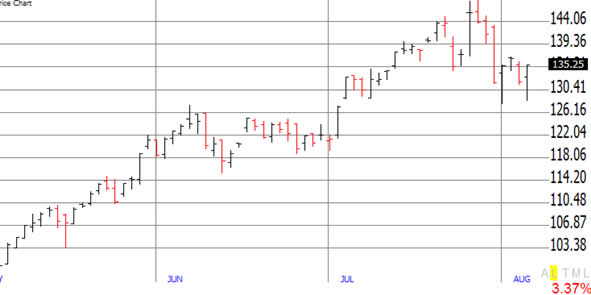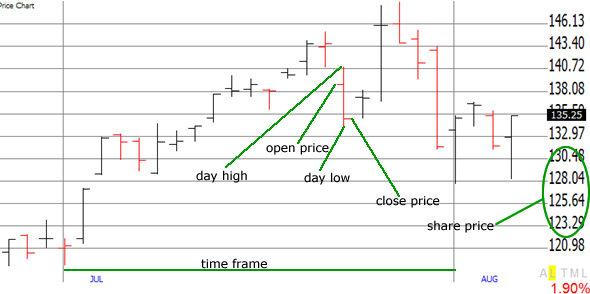Stock price chart explained
A stock price chart is used by stock market traders as part of their technical analysis of a share. The charts simply display where the stock has been, in terms of price, over a time frame (which you can set). Each bar on the chart usually represents a day, however you can change the time frame of the bars to a minute, hour, day, week or month etc.
When viewing a chart, traders normally chose between two ways to view the chart, they use either use OHLC bars (open, high, low, close) or candlestick bars.
Stock chart example 1
Apple | May 2007 – August 2007 | OHLC chart

Stock chart example 2
Apple | May 2007 – August 2007 | Candlestick chart

Stock chart example 3
Apple | May 2007 – August 2007 | OHLC chart close-up
If you take a closer look at the OHLC chart, the day in focus in red. This is because the close price finished lower than the open price.

Stock chart example 4
Apple | May 2007 – August 2007 | Candlestick chart close up
As with the OHLC graph, the day in focus on the candlestick graph is also red. This is also because the close price finished lower than the open price. The candlestick graph just provides a different visual way of looking at a chart. Choosing between a OHLC chart or a candlestick chart is purely a matter of visual preference.

Next steps
Stock charts are fascinating once you learn the many different types of trading patterns that appear and know the indicators that pretty much tell you when to buy! If you think the charts look complicated you are mistaken. It only takes a little time and practice to understand what they mean.
If you are serious about trading stocks and want some hands on experience using charts, then there is a great free website that I recommend – freestockcharts.com
Or you can use MarketClub’s really amazing charting tools and signup for a free 2-week trial to also get some free training on technical analysis.
Screen shots courtesy of tc2000


I don’t understand. On the OHLC graph some of the bars appear to have closed lower than they opened and yet are black not red.The 13th and 16th from the left for example or maybe im missing something. Is the open price always on the left?
Nevermind just realised it’s because its still closed higher than the previous day.
In candlestick chart, I got it. But some black candlesticks are completely filled with black, so what does it mean?
In the above examples, black means the end price of the day finished above the end price of the previous day.